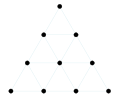Sacred geometry
| Preach to the choir Religion |
| Crux of the matter |
| Speak of the devil |
| An act of faith |
“”What I want is a good, strong monarchy with a tasteful and decent king who has some knowledge of theology and geometry and to cultivate a Rich Inner Life
|
| —Ignatius Reilly, A Confederacy of Dunces[1]:183-184 |
Sacred geometry refers to geometric forms that were once used in the design of holy sites, including Western churches and cathedrals. Geometric forms and/or ratios were given certain esoteric significance and meanings based on their attributes. Many of these meanings were borrowed from the philosophies of the Pythagorean brotherhood, a secret society created by Pythagoras which taught his religious, esoteric, and mathematical beliefs (one of which, interestingly, involved not eating fava beans, for fear of swallowing a living soul in the process. Legend also states they murked a guy for figuring out the square root of 2 is irrational.). These forms were thought to give insight into how the Universe works, or at least symbolize some transcendental aspect of the Universe. Specifically, the mathematical aspects of these forms means they will always be the way they are, by definition, no matter where or when one is.
Because of the religious and philosophical background, its emphasis on geometry and math, and its involvement in the building of churches, sacred geometry has associations with Freemasonry. The medieval stonemasons who designed and built cathedrals probably utilized sacred geometry. Freemasons based much of their practices on those medieval masons. Modern Freemasonry also uses some sacred geometric symbols.[2]
People who work with sacred geometry, for example, Sacred Geometry International[3] often claim that it stimulates both sides of the brain at once: the right side (which in pop psychology deals with art and intuition) and left side (which in pop psychology deals with mathematics and logic). This is a pretty big oversimplification of brain activity; both halves of the brain interact with each other in very complex ways.
Many New Agers buy into the idea of sacred geometry, stating, of course, the idea that sacred geometry is "proven" by quantum physics.[4] They may also make the claim that it is everywhere repeated throughout the Universe, yet still use any examples of it they find as proof of significance. For instance, finding something close to a golden ratio in the proportions of the Giza pyramids as evidence that they were built by super advanced aliens.
Common examples of sacred geometry[edit]
- The Vesica Piscis — two circles of common radius, intersecting each other at their centers. Symbolizes
an almondJesus fisha womb.
- The golden ratio — 1.61803399… The claim is that many (if not all) biological systems are proportioned by this ratio.[5] Many unsupported examples, such as the nautilus shell, are given, but most of them don't even come close.[6] Occasionally, the ratio is even used by Creationists, who claim that God interwove this number into nearly all of creation so we could recognize His influence.[7]
- The Flower of Life — circles arranged in a sixfold, hexagonal symmetry. Probably represents how 'everything is connected'. The first iteration is called the Seed of Life or sometimes the Egg of Life and apparently looks similar to early stages of zygote cleavage divisions so it must represent the birth of the Universe or something of the sort. The Flower of Life is found in many ancient temples.[8]
- Metatron's Cube — named after an archangel in some sects of Judaism. The image is made up of 13 circles arranged in a radial hexagonal symmetry; all of their centers are connected by lines. Images of the five Platonic solids can be derived from these lines (the tetrahedron, cube and octahedron all fit perfectly, but the icosahedron and the dodecahedron need a few extra lines, and the self-intersecting equivalents of the Platonic solids, the Kepler-Poinsot polyhedra, are completely ignored by both Metatron's cube and sacred geometry).
- The Tetractys — a group of ten dots arranged in an equilateral triangle. It was a very important symbol to the previously mentioned Pythagoreans, to the point where they even swore oaths on it. In and of itself, it symbolizes perfection and a perfect world, but each row has its own symbolism: the uppermost dot is the Creator, the row of two dots below that is the world he created, the row of three below that is the combination of the first two rows, and the bottom row of four dots is the four classical liberal arts.[2]
In conclusion[edit]
There is nothing wrong with art, mathematics, and spirituality. There is something wrong when art, mathematics, and spirituality claim to be science in cases where they are not science.
See also[edit]
- Dan Brown
- Washington, D.C. street design conspiracy theory
- Jordan of Spirit Science
fameinfamy really likes sacred geometry
External links[edit]
References[edit]
- ↑ A Confederacy of Dunces by John Kennedy Toole (1980) Louisiana State University Press. ISBN 0807106577.
- ↑ 2.0 2.1 Tetractys MasonicDictionary.com.
- ↑ Sacred Geometry International
- ↑ Chapter 5. The revival of an ancient science (2006) Souls of Distortion.
- ↑ Fibonacci Numbers in Nature & the Golden Ratio (2011) World-Mysteries.com (archived from February 7, 2012).
- ↑ Fibonacci Flim-Flam by Donald E. Simanek (December 2015) Lock Haven University.
- ↑ Phi and Fibonaci Anomalies (2002) The Evolution of Truth.
- ↑ Flower of Life Crystalinks.




